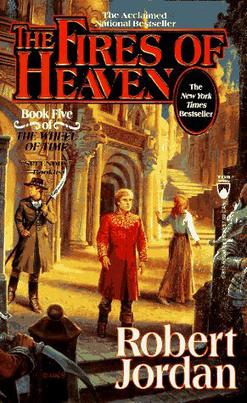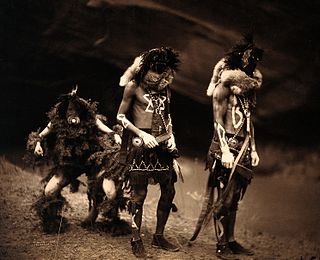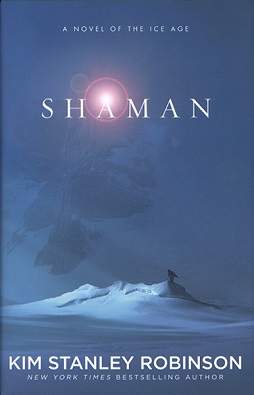First edition covers
- People of the Wolf
- People of the Fire
- People of the Lakes
- People of the Sea
North America's Forgotten Past (occasionally called "First North Americans") is a series of historical fiction novels published by Tor and written by husband and wife co-authors W. Michael Gear and Kathleen O'Neal Gear. The series, which began with 1990's People of the Wolf , explores various civilizations and cultures in prehistoric North America. It is somewhat comparable to Jean M. Auel's Earth's Children series, which is set in prehistoric Europe, but each of its books focuses on a different time period, location, and set of characters. The first four novels form a coherent, more or less linear narrative, from the initial migration of Siberian peoples into what is now Canada and Alaska (People of the Wolf) through the florescence of the Mississippian semi-urban mound-building culture, considered the "high-water mark" of North American pre-Columbian civilization, around 1000 AD. The remaining novels cover a wide variety of times and settings, most standalone stories in no particular order, ranging from tropical Florida in the 6th millennium BC to the Chaco Empire of the Southwest in the 13th century AD. The novels take into account new developments in North American archaeology such as the discovery of Kennewick Man and the development of the coastal-route model as a possible alternative or supplement to overland migration across Beringia.
The novels generally have a prologue set in modern times, in which archaeologists or others discover ancient artifacts and other remnants of prehistoric North American civilization. The main body of the novel then details the individual lives of those who left the artifacts behind. Although generally well regarded for their accuracy and attention to detail (both of the writers are professional archaeologists) the novels usually contain mystic elements, focusing on shamanistic visions. Protagonists of early novels sometimes appear as dream guides or figures of legend in subsequent volumes.
According to the author's website, future titles in the series will include novels dealing with the Pacific Northwest in British Columbia; the high cultures of the Southeast, including Moundville, Alabama, and the Etowah Indian Mounds, Georgia; the Hohokam in southern Arizona; the Mimbres in New Mexico; and the Salado in the Salt River basin.
People of the Wolf ( ISBN 0-8125-0737-1), the first book in the series, the story explores the migration of humans into pre-historic North America. The story starts with a woman being raped on the sea side. She gives birth to twins who are destined to change the history of the People. The novel follows two clans as they make way to new lands during the Ice age. Spurred by a vision he had while on a hunt, a young tribesman named Runs in Light, later called Wolf Dreamer, leads a handful of tribes people, in rebellion against the tribal shaman, south down the Yukon River valley into what is now Canada and the Pacific Northwest.
People of the Fire ( ISBN 978-0-8125-2150-4, 1991) dramatizes the transition of Native American culture from Paleo-Indian to Archaic as a result of climatic warming, set in the High Plains and Western Rockies region. It is the second book in North America's Forgotten Past series.
Amid disastrous climate changes, the Red Hand and Short Buffalo tribes struggle for survival, and against each other. In order to survive in the changing world, they must change with it, but to do that, they need the guidance of a new Dreamer, and the Red Hand's sacred Wolf Bundle must be renewed.
People of the Sea ( ISBN 0-8125-0737-1) dramatizes the initial development of the California Native American culture and the imminent extinction of mammoths and mastodons as a result of climatic warming ca. 8000 BC. It is the fifth book in the series.
People of the Lakes ( ISBN 9780812507478) is the sixth book in the series. The title is a reference to the location and type of natives portrayed in the book, following the naming convention set forth by previous books in the series.
The book is set in the North American continent during the Iron Age (c. 100 CE) and follows the plight of a group of natives trying to save their clan from a great evil and avoid a rival clan. Clan fighting over a powerful totemic mask has brought the Mound Builder people of the Great Lakes region to the edge of destruction. It is up to Star Shell, daughter of a Hopewell chief, to rid her people of this curse. Along with her companions: Otter, a trader; Pearl, a runaway; and Green Spider, either prophet or madman, she braves the stormy waters of the lakes to reach the majestic waterfall known as Roaring Water. She is determined to banish the mask forever to a watery grave. But vengeful clan members are close on her heels, and they have a similar fate planned for her.
Little Dancer/Fire Dancer: A young man of the Red Hand raised in a village of the Short Buffalo People, Little Dancer struggles to understand and come to grips with his emerging shamanic Power. He later becomes Fire Dancer after said Power comes into full bloom.
Two Smokes: An aging Two-Spirit who helps raise Little Dancer while seeking to glean a new food source in light of the dwindling numbers of buffalo.
Elk Charm: The love-interest of Little Dancer, she leaves the Red Hand camp after completing her first menstruation, fearing ambush and rape by Blood Bear.
Tanager: An independent-minded Red Hand warrior-woman amazingly skilled in battle. She is renowned for her ability to outrun men, to evade flying war-darts (spears launched by means of an atlatl) and her ferocity in battle.
Blood Bear: Ferocious war-leader of the Red Hand who becomes Keeper of the Wolf Bundle after reclaiming it from the Short Buffalo People, but shows no respect to the sacred object in private. He is revealed to be Little Dancer's biological father.
Heavy Beaver: Chief of the Short Buffalo tribe who uses false Dreams to obtain power for himself. Heavy Beaver suffers greatly from an Oedipus complex, struggling to prove his worth to the memory of his dead mother.
White Calf: The ancient medicine woman who teaches Little Dancer to harness his Dreams.

Tlālōcān is described in several Aztec codices as a paradise, ruled over by the rain deity Tlāloc and his consort Chalchiuhtlicue. It absorbed those who died through drowning or lightning, or as a consequence of diseases associated with the rain deity. Tlālōcān has also been recognized in certain wall paintings of the much earlier Teotihuacan culture. Among modern Nahua-speaking peoples of the Gulf Coast, Tlālōcān survives as an all-encompassing concept embracing the subterranean world and its denizens.

The Zuni are Native American Pueblo peoples native to the Zuni River valley. The Zuni people today are federally recognized as the Zuni Tribe of the Zuni Reservation, New Mexico, and most live in the Pueblo of Zuni on the Zuni River, a tributary of the Little Colorado River, in western New Mexico, United States. The Pueblo of Zuni is 55 km (34 mi) south of Gallup, New Mexico. The Zuni tribe lived in multi level adobe houses. In addition to the reservation, the tribe owns trust lands in Catron County, New Mexico, and Apache County, Arizona. The Zuni call their homeland Halona Idiwan’a or Middle Place. The word Zuni is believed to derive from the Western Keres language (Acoma) word sɨ̂‧ni, or a cognate thereof.

The Fires of Heaven is a fantasy novel by American writer Robert Jordan, the fifth book in his series The Wheel of Time. It was published by Tor Books and released on October 15, 1993.

The Onondaga people are one of the five original nations of the Haudenosaunee (Iroquois) Confederacy in the Northeastern Woodlands. Their historical homelands are in and around present-day Onondaga County, New York, south of Lake Ontario.

In the classification of the archaeological cultures of North America, the Archaic period in North America, taken to last from around 8000 to 1000 BC in the sequence of North American pre-Columbian cultural stages, is a period defined by the archaic stage of cultural development. The Archaic stage is characterized by subsistence economies supported through the exploitation of nuts, seeds, and shellfish. As its ending is defined by the adoption of sedentary farming, this date can vary significantly across the Americas.
A vision quest is a rite of passage in some Native American cultures. Individual Indigenous cultures have their own names for their rites of passage. "Vision quest" is an English-language umbrella term, and may not always be accurate or used by the cultures in question.

In the classification of archaeological cultures of North America, the Woodland period of North American pre-Columbian cultures spanned a period from roughly 1000 BCE to European contact in the eastern part of North America, with some archaeologists distinguishing the Mississippian period, from 1000 CE to European contact as a separate period. The term "Woodland Period" was introduced in the 1930s as a generic term for prehistoric sites falling between the Archaic hunter-gatherers and the agriculturalist Mississippian cultures. The Eastern Woodlands cultural region covers what is now eastern Canada south of the Subarctic region, the Eastern United States, along to the Gulf of Mexico.

Casas Grandes is a prehistoric archaeological site in the northern Mexican state of Chihuahua. Construction of the site is attributed to the Mogollon culture. Casas Grandes has been designated a UNESCO World Heritage Site under the purview of INAH and a "Pueblo Mágico" since 2015.

An effigy mound is a raised pile of earth built in the shape of a stylized animal, symbol, religious figure, human, or other figure. The Effigy Moundbuilder culture is primarily associated with the years 550–1200 CE during the Late Woodland Period, although radiocarbon dating has placed the origin of certain mounds as far back as 320 BCE.

(Helen) Diane Glancy is an American poet, author, and playwright.

This is a timeline of in North American prehistory, from 1000 BC until European contact.

Native American religions, Native American faith or American Indian religions are the indigenous spiritual practices of the Indigenous peoples of the Americas. Ceremonial ways can vary widely and are based on the differing histories and beliefs of individual nations, tribes and bands. Early European explorers describe individual Native American tribes and even small bands as each having their own religious practices. Theology may be monotheistic, polytheistic, henotheistic, animistic, shamanistic, pantheistic or any combination thereof, among others. Traditional beliefs are usually passed down in the oral tradition forms of myths, oral histories, stories, allegories, and principles.

Prehistory of Ohio provides an overview of the activities that occurred prior to Ohio's recorded history. The ancient hunters, Paleo-Indians, descended from humans that crossed the Bering Strait. There is evidence of Paleo-Indians in Ohio, who were hunter-gatherers that ranged widely over land to hunt large game. For instance, mastodon bones were found at the Burning Tree Mastodon site that showed that it had been butchered. Clovis points have been found that indicate interaction with other groups and hunted large game. The Paleo Crossing site and Nobles Pond site provide evidence that groups interacted with one another. The Paleo-Indian's diet included fish, small game, and nuts and berries that gathered. They lived in simple shelters made of wood and bark or hides. Canoes were created by digging out trees with granite axes.

Shell gorgets are a Native American art form of polished, carved shell pendants worn around the neck. The gorgets are frequently engraved, and are sometimes highlighted with pigments, or fenestrated.
The Eastern Woodlands is a cultural area of the Indigenous people of North America. The Eastern Woodlands extended roughly from the Atlantic Ocean to the eastern Great Plains, and from the Great Lakes region to the Gulf of Mexico, which is now part of the Eastern United States and Canada. The Plains Indians culture area is to the west; the Subarctic area to the north. The Indigenous people of the Eastern Woodlands spoke languages belonging to several language groups, including Algonquian, Iroquoian, Muskogean, and Siouan, as well as apparently isolated languages such as Calusa, Chitimacha, Natchez, Timucua, Tunica and Yuchi. Many of these languages are still spoken today.

Shaman is a 2013 novel by Kim Stanley Robinson. Set during the Ice Age, it tells the story of a trainee shaman, from a tribe of European early modern humans, who must learn the skills to survive and to aid his people.
Jane Whitefield is a crime and mystery novel series written by Thomas Perry. The series features Jane Whitefield, a Native American (Seneca) who has made a career out of helping people disappear. The series is usually narrated in third-person perspective. Perry weaves Native American history, stories, theology, and cultural practices into each novel.
William Michael Gear, better known as W. Michael Gear, is an American writer and archaeologist. He is the author of North America's Forgotten Past series, co-written with his wife Kathleen O'Neal Gear. His novels have been published in 29 languages.